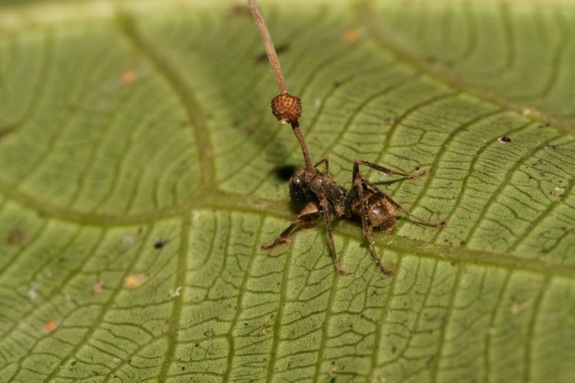Fungus makes zombie ants administer ‘death bite’ at noon
 Researcher David Hughes has expanded research on a parasitic fungus and its carpenter ant host. As explained in an excerpt from a previous EcoTone post:
Researcher David Hughes has expanded research on a parasitic fungus and its carpenter ant host. As explained in an excerpt from a previous EcoTone post:
Scientists have found that the parasitic fungus Ophiocordyceps unilateralis has possibly been invading carpenter ants (Camponotus) for 48 million years. The parasite not only infects the ant, but it manipulates the ant’s behavior, driving it to bite the underside of the leaf at the veins. Once the ant hits an optimal location, the fungus grows rapidly, killing the ant and preparing it to release a new spore.
During this process, the ants leave distinct marks, also known as “death bites,” on the leaves as they bite the veins in search of a prime spot for fungal growth. It is this unique pattern that led researcher David Hughes to a 48 million year old leaf with similar markings. According to a Nature News article, Hughes contacted Conrad Labandeira, a palaeoecologist at the Smithsonian’s National Museum of Natural History, who, as it turns out, had noticed a leaf with similar markings. As Hughes said in the article, “It is not normal ant behavior to bite into the leaf vein because it has no real nutritional value to the ant and can in fact be toxic in some plant species.”
This finding, as he explained in a Biology Letters study published [last year], indicated that the carpenter ants were infected with the parasitic fungus when the ant made the leaf marks. As reported in Discover Magazine’s blog 80beats, “If Hughes’ dating is correct, then the fungi have had plenty of time to fine-tune their zombifying practice into the ruthlessly efficient mind control we see today.”
These findings were recently backed up in a study published by Hughes, now a researcher at Pennsylvania State University, and colleagues in the journal BMC Ecology this week. They found that the ants bit on the leaf veins around noon—a time that appeared to be specific for the fungus. As Hughes said in a Live Science article, “Synchronized arrival of zombie ants at the graveyards is a remarkable phenomenon. It adds a layer of complexity on what is already an impressive feat. However, although ants bite at noon they don’t in fact die until sunset. Likely this strategy ensures (the fungus) has a long cool night ahead of it during which time it can literally burst out of the ant’s head to begin the growth of the spore-releasing stalk.”
The ants—in the case of the most recent study, Camponotus leonardi—live in the canopy of trees but come to the forest floor occasionally. It is here that they contract the fungus. It is also here that the fungus brings the ants, “which zigzag in a drunken walk over low vegetation,” wrote Wynne Perry in the Live Science article, “sometimes falling and convulsing,” to the lower vegetation where the ants will administer the death bite.
Hughes, D., Andersen, S., Hywel-Jones, N., Himaman, W., Billen, J., & Boomsma, J. (2011). Behavioral mechanisms and morphological symptoms of zombie ants dying from fungal infection BMC Ecology, 11 (1) DOI: 10.1186/1472-6785-11-13
Photo Credit: David Hughes (via Live Science)